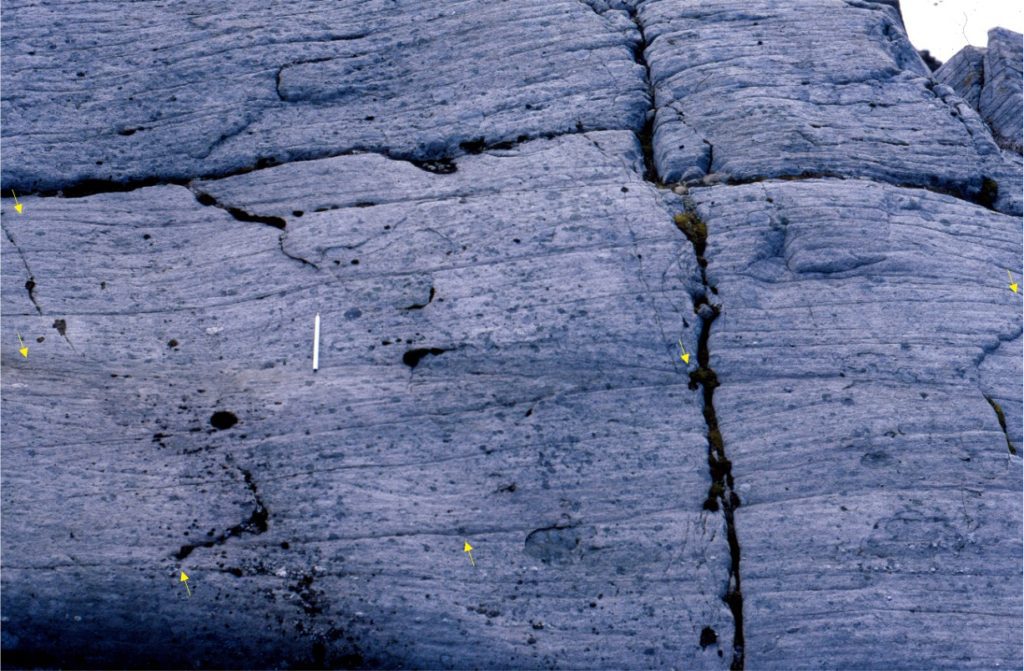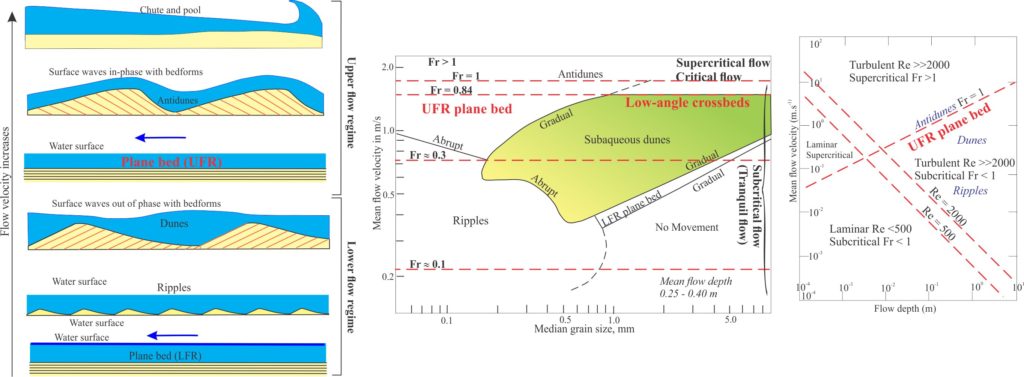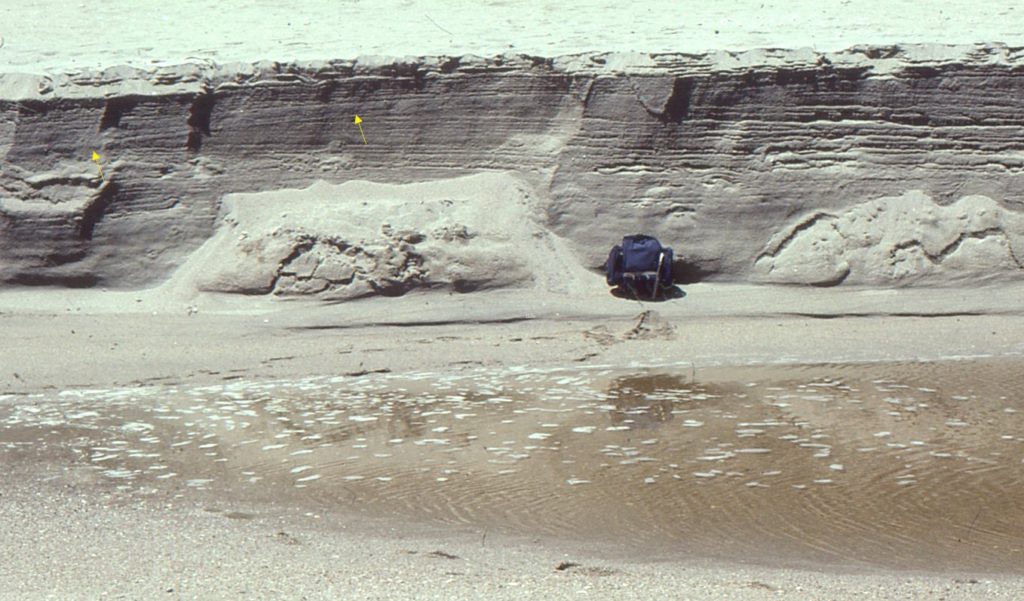An addition to the Lithofacies Series
Use this link to read the introduction to the lithofacies series.
General occurrence
One of the subordinate but no less significant sandy lithofacies, low-angle crossbedded sandstone is commonly is interbedded with plane-bed laminated sandstone. Recognition of both lithofacies in the rock record is important because they preserve one of the few lines of evidence for upper flow-regime hydrodynamic conditions. Low-angle crossbedded sandstone is generally found in fluvial and shallow marine depositional environments. Several authors include low-angle antidune bedforms in this category, but in this series antidune bedding will be treated separately.
External structure
Low-angle in this context refers to the inclination of crossbed foresets with respect to their substrate and the discordant contact between crossbed sets. Their low angle confers a low relief surface expression such that recognition of distinct bedform surfaces such as stoss and lee faces is difficult. In many situations the lithofacies appears more wedge-like. The boundaries between crossbed sets tend to be planar.
Internal structure
The lithofacies general occurs in relatively clean, fine- to medium-grained sandstones. Crossbed laminae dips are generally less than 15o. Likewise, the contacts between crossbed sets also have very shallow dips; in 2D outcrops these contacts are flat. Foresets are usually tangential at their base. If tangential tops are present the foresets have an asymptotic geometry.
Parting lineation is common.


Outcrop view of numerous low-angle crossbed sets in medium-grained sandstone. The discordant contacts between successive crossbed sets are <10o to 12o (a few contacts indicated by arrows). Foreset dips are <15o. The lithofacies is part of a prograding shoreface succession. Pen (left centre) is 15 cm long. Jurassic, Bowser Basin, northern British Columbia.
Miall (2006) has noted that the bedforms can accumulate on surfaces that are initially flat or inclined. Distinguishing between the two conditions is possible by comparing the orientation of the lithofacies with underlying lithofacies, such as laterally extensive ripple bedded units that probably originated on relatively flat substrates.
Formation – hydrodynamic conditions
Deposition of low-angle crossbed lithofacies probably takes place under conditions that span the hydrodynamic interval between upper plane bed flow and formation of antidunes; the presence of parting lineation confirms this interpretation. This corresponds to the transition from subcritical (tranquil) to critical flow (standing waves and antidunes) and supercritical flow.


Summaries of the hydraulic conditions for deposition of upper flow regime bedforms, compared with other bedforms. Data for the graphical plots is mostly from flume experiments:
1- Flow Regime (left); after J.C. Harms & R.K. Fahnestock, 1965,
2- Median grain size and mean current velocities (centre); modified from Ashley, G.M. 1990,
3- Reynolds and Froude numbers as a function of flow depth and flow velocity (right); modified slightly from J.R.L. Allen,1992, Fig. 1.21.
Upper flow plane bed and low-angle crossbed fields are indicated in bold red type.
Common environments
The low-angle crossbedded sandstone lithofacies commonly is associated stratigraphically with upper plane bed laminated sandstone lithofacies. Both lithofacies are important because they preserve upper flow regime hydrodynamic conditions.
In fluvial systems the lithofacies most commonly develops in the proximal regions of crevasse splays that spill from river channels and delta distributary channels. In this setting the lithofacies will be associated stratigraphically and laterally with ripple, interbedded mudstone, and possible organic paleosols that develop across adjacent flood plains. The lithofacies can also fill shallow channel scours.


A section of beach deposits exposed during storm surge erosion and subsequent redistribution of sand to the shoreface. The section contains low-angle crossbeds in well sorted fine- to medium-grained sand – discordant contacts indicated by arrows. The section is parallel to the shoreline (i.e., parallel to depositional strike). Raglan, west coast New Zealand.
Low-angle crossbedded sand and sandstone is common on sandy beaches, particularly in the wave swash and backwash zone. In this case the depositional surface is initially inclined seaward. Like the laminated upper plane bed lithofacies, it will generally occur near the top of coarsening-upward, prograding shoreface successions, as shown in the example below.


Low-angle crossbedded sandstone at the top of a shoaling upward shoreface parasequence (a couple of crossbed set discordances indicated by arrows). The top of the lithofacies is capped by a transgressive, pebbly, fossiliferous limestone – the base of the limestone is the maximum regressive surface (MRS, and the top a flooding surface (FS). Lens cap (bottom centre) is 50 mm wide. The complete parasequence is shown opposite – the location of the crossbed lithofacies is shown by the red outline (top right). Low-angle crossbed and upper plane bed laminated lithofacies are common in the upper parts of all five parasequences (cycles) seen here. The vertical bar scale (lower right) is 5 m long. Mid Jurassic Bowser Basin, northern British Columbia.
Other posts in this series
Sedimentary lithofacies – An introduction
Ripple lithofacies: Ubiquitous bedforms
Ripple lithofacies influenced by tides
Tabular and trough crossbed lithofacies
Laminated sandstone lithofacies
Hummocky and swaley cross-stratification
Lithofacies beyond supercritical antidunes
Subaqueous dunes influenced by tides
Introducing coarse-grained lithofacies
